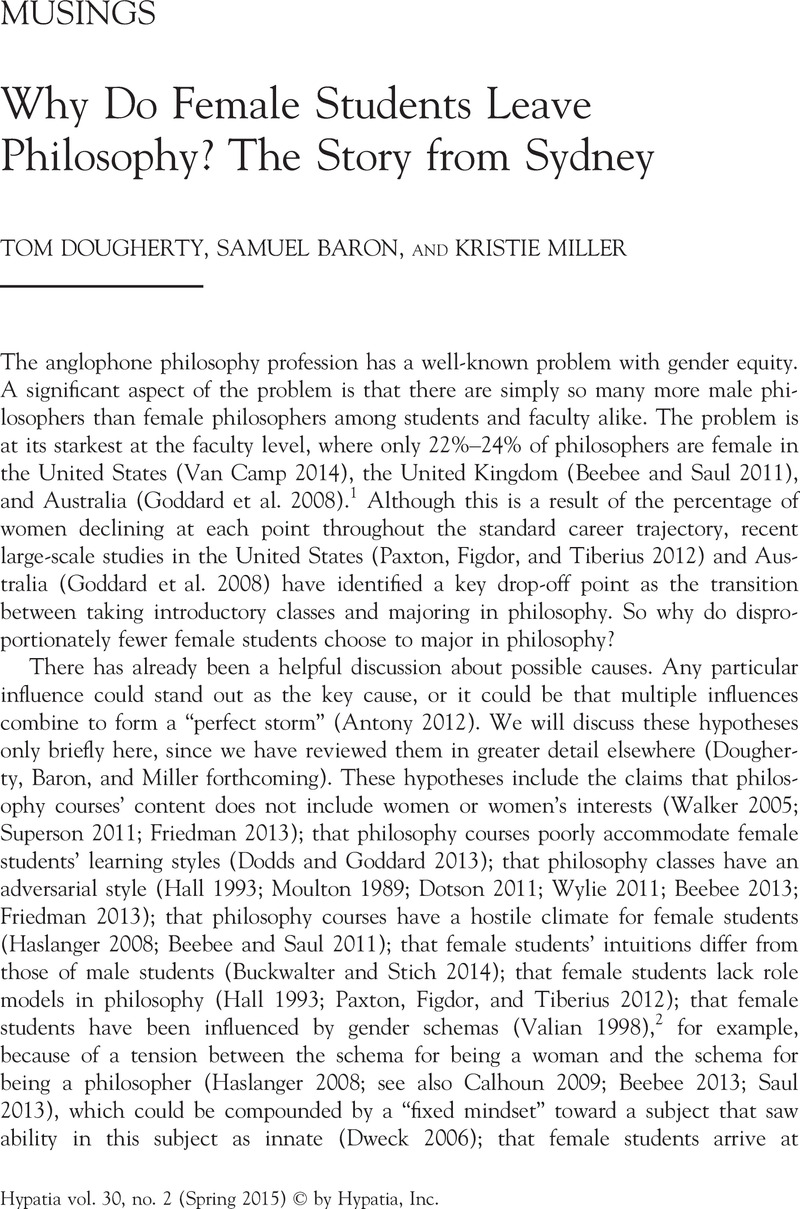Crossref Citations
This article has been cited by the following publications. This list is generated based on data provided by Crossref.
Hansson, Sven Ove
2015.
Philosophy – a Domain for the White Male Genius?.
Theoria,
Vol. 81,
Issue. 3,
p.
189.
Calhoun, Cheshire
2015.
Precluded Interests.
Hypatia,
Vol. 30,
Issue. 2,
p.
475.
Schouten, Gina
2016.
Philosophy in Schools: Can Early Exposure Help Solve Philosophy's Gender Problem?.
Hypatia,
Vol. 31,
Issue. 2,
p.
275.
Holtzman, Geoffrey S.
2016.
Rejecting Beliefs, or Rejecting Believers? On the Importance and Exclusion of Women in Philosophy.
Hypatia,
Vol. 31,
Issue. 2,
p.
293.
Figdor, Carrie
and
Drabek, Matt L.
2016.
A Companion to Experimental Philosophy.
p.
590.
Hermanson, Sean
2017.
Implicit Bias, Stereotype Threat, and Political Correctness in Philosophy.
Philosophies,
Vol. 2,
Issue. 2,
p.
12.
Bright, Liam Kofi
2017.
Decision Theoretic Model of the Productivity Gap.
Erkenntnis,
Vol. 82,
Issue. 2,
p.
421.
Lemay, Marie-Pier
and
Thériault, Mélissa
2018.
Que veulent les femmes ? Le cas de la philosophie en milieu universitaire.
Genre Éducation Formation,
Goddard, Eliza
Grant, Ruby
Tatman, Lucy
Baltzly, Dirk
de la Barra, Bernardo León
and
Black, Rufus
2021.
Women in Philosophy, Engineering & Theology: Gendered disciplines and projects of critical re-imagination.
Women's Studies International Forum,
Vol. 86,
Issue. ,
p.
102479.
Andow, James
2022.
How do philosophers and nonphilosophers think about philosophy? And does personality make a difference?.
Synthese,
Vol. 200,
Issue. 2,
Breidenstein, Joseph I.
2023.
Nietzschean, Feminist, and Embodied Perspectives on the Presocratics.
p.
1.
Ruonakoski, Erika
2023.
Sisters of the Brotherhood: Alienation and Inclusion in Learning Philosophy.
p.
1.
Farieta, Alejandro
and
Delprato, Marcos
2024.
The effect of philosophy on critical reading: Evidence from initial teacher education in Colombia.
International Journal of Educational Development,
Vol. 104,
Issue. ,
p.
102974.
Leopold, Arian
Köller, Michaela M.
and
Renger, Daniela
2025.
Cold Philosophers: Female Students' Perceived Lack of Fit in Stereotypes Is Associated With Underrepresentation.
Journal of Community & Applied Social Psychology,
Vol. 35,
Issue. 1,



